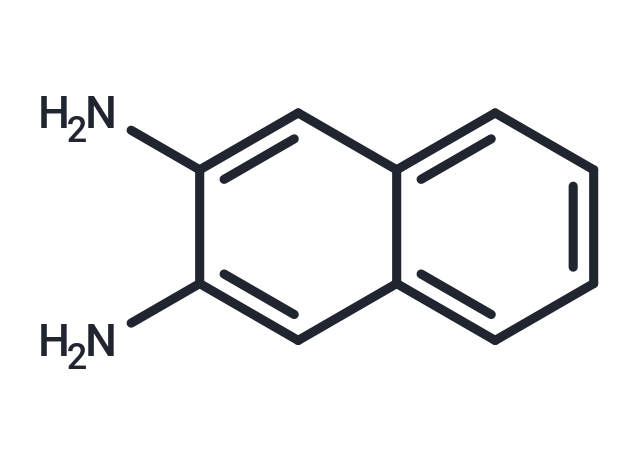Shopping Cart
Remove All Your shopping cart is currently empty
Your shopping cart is currently empty
2,3-Diaminonaphthalene is a highly selective fluorometric and colorimetric reagent for selenium detection, and it is also used for the fluorometric determination of nitrite.

| Pack Size | Price | USA Warehouse | Global Warehouse | Quantity |
|---|---|---|---|---|
| 500 mg | $29 | In Stock | In Stock | |
| 1 mL x 10 mM (in DMSO) | $30 | In Stock | In Stock |
| Description | 2,3-Diaminonaphthalene is a highly selective fluorometric and colorimetric reagent for selenium detection, and it is also used for the fluorometric determination of nitrite. |
| Cell Research | Instructions I. Detection of selenium ions: 1. Solution preparation: 1) First dissolve 2,3-Diaminonaphthalene (usually provided in solid form) in an appropriate solvent, usually pure water or an appropriate amount of acidic solution. The concentration is generally 0.1-10 mM, and the specific concentration can be adjusted according to experimental requirements. 2) It is necessary to prepare a solution containing an appropriate amount of selenium ions, and the concentration is selected according to the experimental design and the required detection sensitivity. 2. Reaction steps: 1) Add 2,3-Diaminonaphthalene solution to the sample, and often react in an acidic environment (such as pH 4-5) to promote the formation of products. 2) The reaction temperature is generally maintained at room temperature, and the reaction time is usually 10-30 minutes. The specific time can be optimized as needed. 3. Detection: 1) Colorimetry: Use a spectrophotometer to detect the absorbance of the reaction product. Usually, the reaction product has an absorption peak at a specific wavelength (such as 320-350 nm). 2) Fluorescence method: If fluorescence determination is performed, it is necessary to excite at a specific wavelength (such as 320 nm) and detect fluorescence emission (usually 400-460 nm). The fluorescence intensity of the product is proportional to the concentration of selenium ions. 3) Data analysis: By comparing with the standard curve, the selenium ion concentration in the sample can be quantitatively analyzed. |
| Molecular Weight | 158.2 |
| Formula | C10H10N2 |
| Cas No. | 771-97-1 |
| Smiles | NC1=CC2=CC=CC=C2C=C1N |
| Relative Density. | 1.0968 g/cm3 |
| Color | White |
| Appearance | Solid |
| Storage | keep away from direct sunlight | Powder: -20°C for 3 years | In solvent: -80°C for 1 year | Shipping with blue ice/Shipping at ambient temperature. | |||||||||||||||||||||||||||||||||||
| Solubility Information | DMSO: 90 mg/mL (568.9 mM), Sonication is recommended. | |||||||||||||||||||||||||||||||||||
| In Vivo Formulation | 10% DMSO+40% PEG300+5% Tween-80+45% Saline: 3.3 mg/mL (20.86 mM), Sonication is recommeded. Please add the solvents sequentially, clarifying the solution as much as possible before adding the next one. Dissolve by heating and/or sonication if necessary. Working solution is recommended to be prepared and used immediately. The formulation provided above is for reference purposes only. In vivo formulations may vary and should be modified based on specific experimental conditions. | |||||||||||||||||||||||||||||||||||
Solution Preparation Table | ||||||||||||||||||||||||||||||||||||
DMSO
| ||||||||||||||||||||||||||||||||||||
| Size | Quantity | Unit Price | Amount | Operation |
|---|

Copyright © 2015-2026 TargetMol Chemicals Inc. All Rights Reserved.